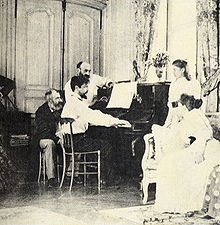| The Little Nigar | |
|---|---|
| Cake Walk | |
| Piano music by Claude Debussy | |
 Debussy at the piano in 1893 Debussy at the piano in 1893 | |
| Other name | The Little Negro / Le petit nègre |
| Key | C major |
| Catalogue |
|
| Composed | 1909 (1909)? |
| Published |
|

Problems playing this file? See media help.
The Little Nigar (CD 122, L. 114) is the original title by composer Claude Debussy for a short piece for piano, composed in 1909 for a piano method and published the same year. It was later also published as a single piece, entitled The Little Negro and Le petit nègre. In more recent times, the piece has also been published under the title Le petit noir (The Little Black).
History
Debussy composed The Little Nigar (giving the noun this spelling) in 1909 on a commission from Théodore Lack, for his piano method Méthode de Piano. The subtitle describes it as a cakewalk. It is reminiscent of Golliwogg's Cakewalk from his Children's Corner, a piano suite that he had composed a year earlier.
Debussy regularly sought exotic influences. In The Little Nigar, he alluded to banjo chords and drums, influenced by American minstrel shows. The piece, marked allegro, begins with a first theme presenting "jazzy" syncopes in
4 time, in the then popular ragtime style. It is followed by a lyrical passage, marked espressivo and pianissimo (very softly), which leads to a return of the first section. The first theme leans towards pentatonic and is accompanied by a chromatic sequence of broken minor thirds.
The Little Nigar was first published in 1909 by Éditions Alphonse Leduc in Paris as part of Lack's piano method and again as a single piece in about 1934, now with an added repetition and entitled The Little Negro, with subtitle Le petit nègre.
Debussy also used the piece's main theme in his 1913 ballet for children, La boîte à joujoux, in which it characterises an English soldier.
Numerous transcriptions have been made of the piece, including an arrangement for woodwinds that has been used for advertising Purina One dog food.
Literature
- Schmitz, E. Robert (1950). The Piano Works of Claude Debussy, foreword by Virgil Thomson. New York: Duell, Sloan & Pearce.
References
- McKinley, Ann (1986). "Debussy and American Minstrelsy". The Black Perspective in Music. 14 (3). JSTOR: 249–258. doi:10.2307/1215065. ISSN 0090-7790. JSTOR 1215065.
- ^ "The little Nigar". Centre de documentation Claude Debussy. Retrieved 4 August 2018.
- ^ Heinemann, Ernst-Günter. "Postface" (PDF). Henle. Retrieved 4 August 2018.
- ^ Scheytt, Jochen (2017). "Le petit nègre". jochenscheytt.de. Retrieved 4 August 2018.
- ^ Smith, Lindy (2008). "Out of Africa: The Cakewalk in Twentieth-Century / French Concert Music". Nota Bene: Canadian Undergraduate Journal of Musicology. 1 (1): 75–80. Retrieved 4 August 2018.
- ^ Andres, Robert (2005). "An introduction to the solo piano music of Debussy and Ravel". BBC. Retrieved 4 August 2018.
- "The little Negro". Henle. Retrieved 4 August 2018.
- Eichmann, Andreas, ed. (2014). Kurt Weill und Frankreich (in German). Waxmann Verlag. p. 46. ISBN 978-3-83-098077-3.
- Brown, Matthew (2012). Debussy Redux: The Impact of His Music on Popular Culture. Indiana University Press. p. 5. ISBN 978-0-25-335716-8.
External links
- The Little Nigar (Debussy, Claude): Scores at the International Music Score Library Project
- The little nigar (recordings) muziekweb.nl
- Christine Stevenson: N is for Negre – Debussy’s Le Petit Negre notesfromapianist.wordpress.com 2012
- Debussy: The little nigar(Ichiro Kaneko) on YouTube
Categories: